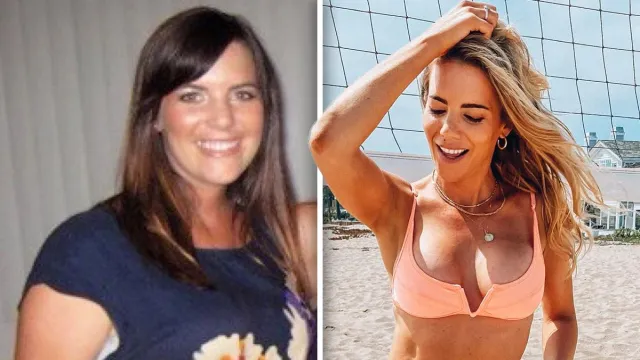She Broke 9 "Weight Loss Rules" and Lost 45 Pounds — Here's How

Have you been following all the "right" weight loss advice but still struggling to see results? You're not alone. For years, I followed conventional wisdom that actually made losing weight harder, not easier. Katie Dunlop, a certified personal trainer, transformed her body by shedding 45 pounds and flattening her belly—but only after she started breaking the very rules she thought were helping her. Discover which weight loss rules might be sabotaging your progress and what actually works instead.
I Stopped Assuming Healthy Foods Automatically Lead to Weight Loss
"I started eating all these healthy foods like avocados and nuts and made dressings with tons of oils," Katie shares in her post. "I was eating healthy, but when it came to losing weight, it just wasn't happening." While nutritious foods are essential for your health, Katie learned that calories still matter. Studies show people underestimate calories from healthy foods by up to 50%. That "healthy" meal might be twice as calorie-dense as you think.
RELATED: I Got My Best Body After 50 and Here's How You Can, Too
I Rejected the "No Eating After 7 PM" Rule
Katie admits, "I would cut myself off at seven, even if I hadn't had dinner or enough to eat. What usually happened is that I'd end up binging at night." Breaking this arbitrary time rule transformed her approach. The time you eat doesn't matter for fat loss—it's your total daily intake that counts, Katie discovered. You can eat dinner at 10 PM and still lose weight if you stay within your overall calorie goals. For digestion, Katie now recommends a two-hour window before sleep without eating.
I Started Embracing Carbs, Not Cutting Them
"If you cut carbs out of your diet, you'll probably notice initial weight loss because you're eating less," Katie explains, "but it's definitely not going to help you lose weight long-term." Breaking this popular diet rule was game-changing. Research shows cutting carbs can be particularly harmful for women since we need them to balance hormones and energy levels. Katie warns that eliminating carbs increases stress and cortisol levels, making fat loss even harder over time.
RELATED: I'm a Nutritionist and These are the Best Banana Recipes For Weight Loss
I Stopped Believing in Spot Reduction
https://www.instagram.com/reel/DFgM1NoTXNf/?utm_source=ig_embed&utm_campaign=loading
"You can't say, 'Oh, I have this belly fat right here. How do I get rid of my belly fat? How do I get rid of my love handles?'" Katie points out. "We cannot spot reduce it." Instead of focusing on targeted exercises promising to melt fat from specific areas, Katie learned that overall strength training and caloric deficit were the keys. Women typically hold weight in the lower belly and triceps, so these areas improve as overall body fat decreases.
I Quit Stressing About Eating Every 2-3 Hours
"I remember I would stress about this. I would be on the clock waiting, thinking 'Shoot, I gotta keep it going, I gotta make sure I'm eating every two to three hours,'" Katie recalls. Breaking this rule freed her from unnecessary stress. Research shows your total daily nutrition matters more than eating frequency. Katie now focuses on balanced meals with healthy fats, proteins, carbohydrates, and fiber rather than obsessing over timing.
I Stopped Fearing Fat in My Diet
Katie admits, "I was convinced for years that my low-fat yogurts, low-fat cookies, low-fat crackers were good for me and would help me maintain a lower weight—and they didn't." Breaking this rule transformed her nutrition. Healthy fats from avocados, nuts, and olive oils are essential for hormone balance and feeling satisfied. The problem with many low-fat products, Katie discovered, is their high sugar content, which can be more harmful than moderate amounts of good fats.
RELATED: Tone Sagging Arms in 2 Weeks With These 5 Exercises
I Stopped Relying on the Scale to Track Progress
"The scale is not the best way to track your fat loss," Katie emphasizes. "As women especially, the scale goes up and down three to five pounds day to day, week to week, depending on our cycle and water retention." Breaking free from scale obsession gave Katie a more accurate view of her progress. When gaining muscle while losing fat, the scale can be particularly misleading. Katie now recommends taking photos and measurements instead.
I Abandoned the "All or Nothing" Approach
"I used to live in this all-or-nothing mentality, and it would be the greatest excuse I ever had," Katie shares. "I'd say, 'It's never going to work because I can't meal prep' or 'I can't make all my food at home.'" Katie rejected the rule that you must eat "clean" 100% of the time. She ditched "cheat days" in favor of an 80/20 lifestyle where making better choices most of the time allows for flexibility without derailing progress.
RELATED: What Happens When You Quit Soda, According to a Nutritionist
I Rejected the "Slowing Metabolism After 30" Myth
"Every day I hear that once you turn 30, your metabolism starts going downhill, or once you hit 40, or during perimenopause or menopause, nothing works anymore," Katie notes. Breaking this rule changed her entire perspective on aging and fitness. Research shows metabolism doesn't significantly change from ages 20 to 60. What does change is muscle mass—we lose 3-5% of muscle every decade after 30. Katie now knows that strength training becomes more important with age, not less. "All the data shows that no matter what age or phase you're at, the more you increase and focus on strength training and protein intake, the more you'll continue to see results."
Remember, sustainable weight loss isn't about following arbitrary rules—it's about understanding what actually works for your body. Which of these "rules" have you been following? Breaking them might be exactly what you need to finally see results.




